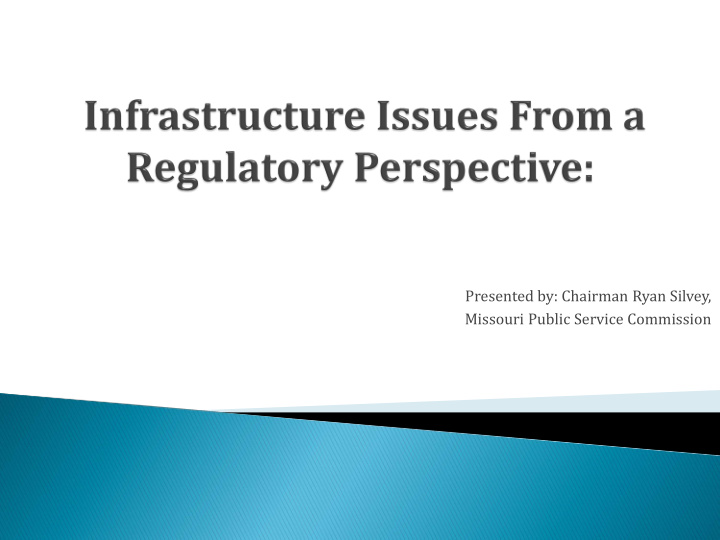



Presented by: Chairman Ryan Silvey, Missouri Public Service Commission
Views expressed in this presentation are that of Ryan Silvey and do not represent the views of the Missouri Public Service Commission.
PSC regulates public utilities under powers granted in the Public Service Commission Law. “The guiding star of this act and the dominating purpose of utility regulation are the promotion and conservation of the interests and convenience of the public.” State ex rel Crown Coach Co. v. Public Service Com’n (App. 1944) 179 S.W.2d 41 “Its purpose is to require the general public not only to pay rates that will keep public utility plants in proper repair for effective service, but further to insure to the investors a reasonable return upon funds invested.” State ex rel. Washington University v. Public Service Commission of Missouri (Sup. 1925) 272 S.W. 971.
What infrastructure upgrades are needed for safe and adequate service? Are utilities entitled to recovery for the costs in rates? If so, how should those costs be recovered?
Smart Meters – Advanced Metering Infrastructure (AMI) “We went from getting one meter read per month to 3,000 per month.” Senior engineer at electric cooperative in Ohio.
KU: install and deploy KPSC’s Key Findings: 531,000 electric meters ◦ Failed to prove meters for $161.9 million needed to insure adequate service. LG&E: install and deploy ◦ Asking customers to pay 413,000 electric meters for new system AND and 334,000 natural gas $52.9 million in meters for $178.5 unrecovered costs of existing meters. ◦ Failed to commit to pass on savings from smart meters to their customers. When evaluating odds of a net cost benefit, KPSC found likelihood “is too marginal and the risk to ratepayers is too great.”
Decisions of a Public Service Commission Based on Facts. ◦ Kentucky PSC distinguished its prior order approving Duke Energy Kentucky’s smart meter application based on need for new meters to provide reliable service and benefits being offered to ratepayers. Need to see benefits to ratepayers ◦ Ability to access real-time information on usage? ◦ Time of Use rate options?
Missouri American Water Company requested recovery through rates of costs in 2017 for Lead Service Line Replacement Program and authority to continue tracking program costs Lea Lead Ser Service Li Lines ( (LS LSL) – service line connecting water distribution main in street to customer’s home. Customers normally responsible for maintaining and replacing portion of line from main to home.
Full LSL Replacement Partial LSL Replacement Only a portion of the All segments of service service line with lead is line that contain lead replaced while portion are removed. of line owned by the customer remains.
Report and Order Issued on May 2, 2018: Approved recovery of Missouri-American’s LSLR Program costs through December 31, 2017. $1,668,797 million amortized over 10 years. ◦ Commission did not approve Missouri-American’s request for both recovery of costs ◦ and a return on the value of the customer-owned service lines. Allowing Missouri-American to continue tracking ongoing costs for the program for consideration of potential recovery in a future general rate case. Agreed with Public Counsel and created a working group to evaluate information from the LSLR Program and to evaluate: Prudency of costs ◦ Feasibility of prioritizing at-risk population ◦ How utility will proceed when lacks customer consent ◦ How to handle unusual site restorations ◦ Maintaining records ◦
Kansas City Power and Light Company v. Missouri Public Service Commission , (W.D. 2018) 557 S.W. 3d 460. Court reversed MoPSC’s Report and Order and determined that KCP&L’s electric vehicle charging stations constitute “electric plant” within the meaning of Section 386.020(14) RSMo.
• Ameren Missouri filed tariff sheets for “Charge Ahead” program on February 22, 2018. • PSC issued Report and Order on February 6, 2019. • Approved Pilot Program for the EV Charging Corridor Program to stimulate development of a public minimum practical network of EV corridor charging infrastructure, including Level 3 DCFC across Ameren’s service area. • Incentive offered through reverse auction for 8-15 sites • Must have both Level 2 and DCFC charging capabilities.
MOPSC directed opening of working docket to involve stakeholders to address various ownership models for EV charging stations. Participants allowed to consider and evaluate additional models, but Commission directed them to evaluate the following three models: Similar to the one stipulated by the parties in KCP&L’s last rate 1. case where utility can own and operate the charging stations A “make ready” tariff proposal with an option to waive line 2. extension charges from a customer seeking line extension for separately metered EV charging that meets specific public policy considerations. Alternative incentive program where program parameters, 3. implementation, and cost recovery would be evaluated and defined in future rate proceeding.
4500 4000 3500 3000 2500 Number of EV's Registered with DOR 2000 Number of EV's Registered with DOR in the KC Area 1500 1000 500 0 2016 2017 2018 Jan 1st - April 26th 2019
4500 4000 3500 3000 Number of EV's Registered with DOR 2500 Number of EV's Registered with DOR in 2000 the KC Area Number of EV's Registered with DOR in the St Louis Area 1500 1000 500 0 2016 2017 2018 Jan 1st - April 26th 2019
Top 10 Counties with an EV Registration CY2018 1600 1400 1200 1000 800 Number of EV's Registered with DOR 600 400 200 0
Top 10 To 10 Co Counties - Jan an 1s 1st - April 26t 26th 2019 2019 1600 1400 1200 1000 800 Number of EV's Registered with DOR 600 400 200 0
Recommend
More recommend